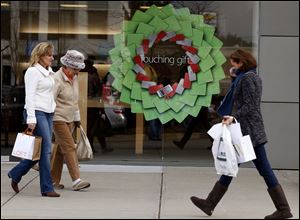
Holiday shopping slows as fiscal worries grow
12/15/2012
Holiday shoppers haven’t found the same heavy discounts as in years past, but prices may fall as retailers seek sales.
NEW YORK — If shoppers don't show up in stores soon, more 70-percent-off sale signs will.
After a promising start to the holiday shopping season over the four-day Thanksgiving weekend, sales have slowed as concerns that include about weak job growth have caused Americans to spend less.
That puts pressure on J.C. Penney, Macy’s, and other stores, which had been offering fewer discounts than they did last year, to step up promotions to lure shoppers such as Ron Antonette of Long Beach, Calif.
Mr. Antonette so far has spent about $1,000 on Legos, a Wii U game console, and an iPad Mini tablet computer for his two young children. Even though that’s just half of what he planned to spend for the season, Mr. Antonette has stopped shopping because of fears that Congress and the White House won’t reach a budget deal by January.
“I basically stopped moving forward in buying,” said Mr. Antonette, 44, who runs a small public relations business and worries that he might not be able to take mortgage deductions on his house next year. “I feel like we're in financial limbo.”
Overall, holiday sales are up 2.2 percent to $659 billion from Nov. 1 through Dec. 8, according to an analysis of sales data done for the Associated Press by ShopperTrak, a Chicago firm that tracks spending at 40,000 stores across the country. That’s slightly below the 2.7 percent increase over the Thanksgiving weekend, when shoppers spent $22 billion.
The modest increase means sales for the rest of the season will be crucial for stores, which get as much as 40 percent of their annual sales in November and December.
To salvage the season, they may offer heavy discounts. That move helped boost sales last year, but also ate away at their profits. That’s something stores have tried to resist.
Stores have been doing more creative things with pricing to get shoppers to think they’re getting a better deal than they really are. Think: Offering jeans for $9 instead of $9.99, hoping round numbers will appeal more to shoppers, or selling two shirts for $20 instead of giving shoppers 20 percent off.